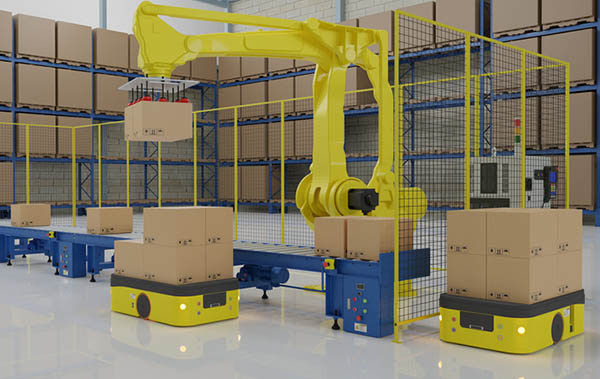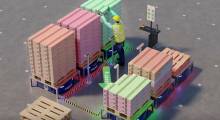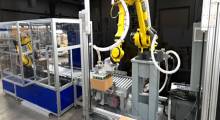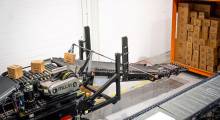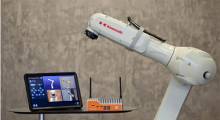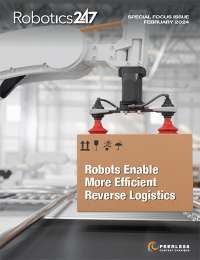There is no end in sight for the massive shortage of skilled workers, especially when it comes to labor-intensive sectors. By some calculations, the warehousing industry alone needs to fill nearly half a million jobs. People who traditionally worked these positions are retiring or quitting in droves, and younger generations don’t gravitate to work that is often dull, dirty, or dangerous.
Drilling down, one of the most labor-intensive jobs in the warehouse or manufacturing floor remains palletizing. For this reason, it’s one of the best areas to target your automation dollars, said Joe Campbell, senior manager of strategic marketing and application development at collaborative robot leader Universal Robots.
“Palletizing has been low-hanging fruit for years,” he said. “If you have openings for these jobs, you’re probably not filling them.”
The reluctance of humans to take on this task has been a boon for robotics. While not a new technology or concept, semi-automated and fully automated palletizing is now enjoying popularity and high adoption. Equipment is also evolving into more sophisticated systems capable of managing end-to-end palletizing and depalletizing operations.
“The desire to work in manual labor jobs is at an all-time low,” said Norman Leonhardt, director of business development at logistics supplier Witron. “At MODEX recently, everything was about automation this year. In the past, that wasn’t always the case.”
In addition, where employees used to resist robots and automation, they now welcome them into collaborative roles.
“Interest is at an all-time high,” said Josh Cloer, director of sales at robot software provider Mujin. “The situation has evolved into a matter of: ‘Can you do this work without automation?’”
All of this makes the return on investment (ROI) less of a question and more of an urgent need. There has never been a better time to justify automated palletizing equipment.
Overcoming palletizing challenges
While plenty of progress has been made in making palletizing equipment more capable, the biggest challenge for fitting it into your processes remains the fact that it’s best suited for high-volume, low-mix operations.
“It’s tougher if you have a high-mix, low-volume combination,” Campbell explained. “And production runs can vary widely based on demand from the market, which adds another layer of complexity.”
Today’s e-commerce-heavy operations do not fit the low-mix side of the profile, which has led to innovation.
Cloer said that single-SKU pallets are an easy, tried-and-true application for automated palletizing. But building orders with a variety of SKUs does remain the more complicated solution.
“You need an automated upstream system that can buffer and sequence cases,” he said. “There’s a lot that goes into the process. We’ve been using software and 3D vision to ask for the appropriate sequence from upstream automation. Then the robots can buffer and re-sequence to build multi-SKU pallets.”
Palletizing equipment is starting to become more flexible and is keeping up with the evolving state of the industry. “We’re seeing more flexible solutions that can manage in these varied environments,” said Campbell.
Palletizing with cobots is seeing explosive growth, he noted. “You can set up palletizing cells that are very flexible and can be redeployed from line to line, depending on your production mix,” Campbell explained. “They are easy to set up and behave more like a tool you deploy when you have a problem.”
Leonhardt agreed that flexibility is key today. “We keep it simple,” he said. “We have a robotic arm that pushes pallets to a predefined spot. The palletizer can handle any size case, bag, or box.”
Like a Lego set, Witron’s products offer flexibility, claimed Leonhardt. “Every case is different, and there’s lots of sorting ahead of time,” he said. “It’s very precise, automated work so that the cases arrive at the pallet at the right time and order for assembly.”
These systems are designed to be a good fit for retailers, food and beverage makers, grocers, and consumer goods manufacturers.
Integrated software plus robotics equals success
Software integration—and increasingly artificial intelligence and machine learning—is playing a bigger role in automated palletization. For instance, Universal Robots recently partnered with RightHand Robotics to power a three-robot offering that works with various materials handling systems like automated storage and retrieval systems (ASRS).
The hardware and the AI together offer easy configuration of sources and destinations and workflows. Performance can top more than 1,200 units per hour at a reliability rate of more than 99.5%, said the companies.
There are also cobots designed for heavier payloads. Universal Robots has built-in palletizing programming that works along with a conveyor and a gripper.
The gripper works as part of a plug-and-play setup that the company bills as a full ecosystem enabling smoother automation. Universal Robots also recently announced its new UR20 cobot arm.
Witron also offers end-to-end systems. “The palletizers are integrated into the entire warehouse management system [WMS] and connected through the entire distribution center,” said Leonhardt.
This might look like sequencing in storage to make sure products arrive at the palletizer at the right time and order. “The WMS manages redundancy, forecasting information, velocity of movement, and more,” Leonhardt said. “The palletizer is the end of the assembly line.”
Witron can also track what a pallet looks like—its condition, how stable it is, whether the stretch wrap is doing its job or might need adjusting.
In addition, because Witron works closely with the grocery industry, it can also track every product in its system back to the purchase order, as well as expiration dates and whether its fresh or frozen. This ensures the products meet the palletizer in the right condition for shipping.
Depalletizing and ROI
While palletizing is making strides, it’s the older sibling to depalletizing, which is now coming on strong in manufacturing and warehousing. Honeywell Intelligrated, which has been in the palletizing space for 20 years, has been evolving the equipment over time.
“It started with fixed, static inline palletizers that worked with single, layered products,” said Thomas Evans, robotics chief technology officer at Honeywell Intelligrated. “Since then, we’ve made the systems more intelligent with AI or machine learning algorithms that give the robots the intelligence to individually pick and place items.”
It all comes down to customer demands and needs, he noted. “We’re creating technology and an evolving product line to increase flexibility and adapt to what we’re seeing in the market,” Evans said.
A big piece of that now is depalletizing equipment, driven again by the uptick in e-commerce and the shortage of available labor.
“If we present a Smart Flexible Depalletizer that can handle variations, it can make an immense difference in productivity,” said Evans. “It adds stability to your shift. The robot ‘worker’ is reliable, and you can count on it working within a very specific plus or minus of your desired rate.”
A depalletizer might be able to manage between 500 and 800 packages an hour, according to Evans. Handled manually, and that number drops to between 300 and 600.
“If you’re consistently running at that higher output, it’s just a couple of years to develop an ROI,” he explained. “That’s appealing to customers.”
Cobots and palletizing
Universal Robots also has a collaborative depalletizing project with Mujin. “We have a mixed unit-load depalletizer,” said Campbell. “It can manage a dozen different products from various manufacturers, stacked randomly, even at odd angles, and still identify where to depalletize into the right boxes.”
If you’re going to use a depalletizer in a fully automated environment, that might include a conveyor that runs the pallets to the robot, or even an autonomous vehicle to do the same. Also, 2D and 3D cameras plus custom software can tell the robot where to go to collect the package safely and intact.
On the whole, the rate of ROI for palletizing and depalletizing will have a wide range. “A single-SKU operation is easily justified,” says Cloer. “With a mixed SKU operation, the robot piece of the puzzle requires a big investment, but there’s still a lot of return.”
Traditionally, a two-year payback on a palletizer investment was typical and considered warranted. “That number is shifting and getting faster due to the labor shortage,” Cloer says. “Automation provides resiliency in your supply chain, and that’s a worthwhile payback.”
Leonhardt observed that proving ROI is a different calculation than in the past. “It’s going to vary depending on your circumstances and location,” he said. “But they can return investment in unexpected ways.”
Building denser pallets, for instance, can help save transportation costs. Stable pallets that don’t fall over is another small gain. Building pallets that allow for orderly unloading at retailers increases accuracy and speed, as does the reduction in mis-picks when machines take the place of humans.
From Campbell’s perspective, collaborative palletizers are the way of the future. “They are going into environments that traditional robots couldn’t,” he said. “We’re breaking new ground with these collaborative efforts, entering markets that couldn’t consider this type of automation in the past.”
About the author
Amanda Loudin is a contributing editor at Logistics Management, a sibling site to Robotics 24/7.
Article topics
Email Sign Up

